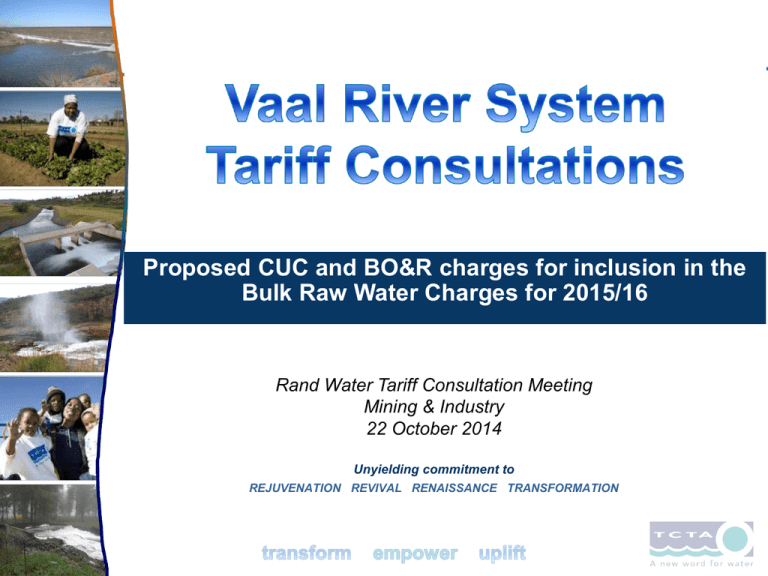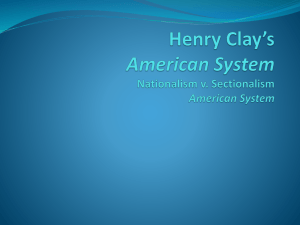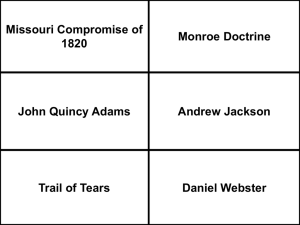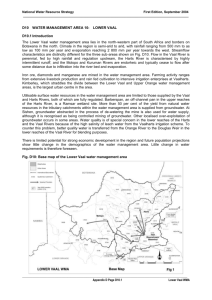transform empower uplift
advertisement

Proposed CUC and BO&R charges for inclusion in the Bulk Raw Water Charges for 2015/16 Rand Water Tariff Consultation Meeting Mining & Industry 22 October 2014 Unyielding commitment to REJUVENATION REVIVAL RENAISSANCE TRANSFORMATION Purpose of the presentation Categories of bulk raw water charges Purpose of the CUC and BO&R charges Stakeholders’ objectives Tariff objectives Principal assumptions & inputs Tariff principles & methodology Proposed CUC and BO&R charges for 2015/16 Debt analysis 2 Discuss purposes for which the CUC is levied on the VRS Discuss the principles and method applied to the setting of the CUC Present the assumptions and inputs underlying the proposed charges Present the proposed CUC and BO&R charges for 2015/16 Discuss implications for the debt of the VRS augmentation schemes 3 Tariff categories for off-budget schemes: Capital Unit Charges (to repay debt) Bulk Operating and Royalties Charge (to repay royalties and bulk O&M) Water Use Charges (statutory charges as per Pricing Strategy) Operations and Maintenance Charges (State schemes portion) Betterment and Refurbishment Charges (if applicable) CUC and BO&R recovers: Capital expenditure Funding costs Administration costs (TCTA, LHDA, LHWC) Royalties Bulk O&M (not included in DWS O&M) 44 The CUC recovers the cost of off-budget schemes in the VRS as provided for in the Pricing Strategy Costs to be recovered over a period not exceeding 20 years after implementation of latest augmentation scheme Current schemes in the VRS: LHWP-1 management of current ongoing debt obligations LHWP-2 next Lesotho scheme to augment the yield of the VRS AMD Government waterworks to mitigate the effects of acid mine drainage in the VRS and augment the yield of the VRS Bulk operations (O&M on non-state schemes) Royalties – paid to Lesotho in terms of Treaty 5 TCTA Secured income stream Contractual right to pass tariffs through to DWA Sustainable projects Banks and Investors Timeous repayment of loan SARB Administered prices for inflation targeting National Treasury Government’s risk protected - Bankable project Affordable services to the people Sustainable debt levels in the water sector - debt overlap Responsible utilisation of state guarantees DWS Inflationary increases in raw water as start of water chain input cost Affordability and predictability to end-users Uncomplicated annual tariff consultations – inflationary increases Water demand management incentive (pay on actual use) No cross subsidisation between projects – transparency of costs Compliance with Water Pricing Strategy 6 SALGA Inflationary increases Fair tariff structures Municipalities Limited to inflationary increases, including raw water components DWS expects TCTA to support this objective Municipality and Council pressure to keep increases low Water sector and end users Tariff stability and predictability Affordable water Inflationary increases acceptable No cross subsidisation between projects – transparency of costs Annual tariff consultation to approve tariff adjustments 7 DWS SARB National Treasury Stakeholders (Rand Water, Major off-takers, SALGA) Banks informed End user affordability Considerations to support end user affordability: Considerations to support debt management: • Under recovering in early years •+20 year repayment period • End-user pays on actual use • Peak of debt in relation to value of asset (limit interest capitalisation) • Constant tariff in real terms approach – CPI targeting • Phasing-in of large tariff adjustments over 2-3 years • Take account of future augmentation – future affordability • No reserves built into tariffs 8 Debt outstanding • Actual cost transfer – TCTA not profit taking • Risk transfer to end-user – trigger adjustments if input assumptions change • Water sector debt profile – debt overlap with future schemes • Interest rates mostly fixed • Utilisation of explicit Government guarantees and impact on National Treasury Inflationary adjustment CPI annually (May index) CPI Cap and floor levels Floor Cap 7.5% 4.5% Negotiated adjustment Automatic adjustment Negotiated adjustment Tariff review triggers Variances between budget and actual for previous year Changes in capital cost Changes in water demand Changes in funding cost Changes in timing and cost of future augmentation schemes (dependant on system yield) Changes in regulatory or legislative environment Changes to operations and maintenance costs (TCTA and LHDA O&M) Changes in any input assumptions that increase/decrease final repayment date 9 Previously TCTA accounted for and determined capital tariffs for each subcomponent of the Vaal River System in isolation (e.g L:HWP-1, LHWP-2 etc.) This approach resulted in an accumulation of tariffs required to repay the subcomponents simultaneously when there was a debt overlap period – when LHWP- 2 phasing-in was introduced, the debt overlap between LHWP-1 and LHWP-2 was severe To address the tariff affordability, smoothing of the tariff was considered to take account of the augmentation required in the Vaal River System TCTA’s funding programme and borrowing limit for all sub-phases of the Vaal River System has been combined to accommodate a smoothed tariff approach To give effect to the integrated system’s tariff approach, a single system capital tariff is therefore charged whereby the combined debt of the Vaal River System will be repaid through a single capital tariff 10 LHWP 1&2 combined debt curve 2013 30.000 27.000 24.000 LHWP-1 debt curve: 2013 Rand Value (Billion) 21.000 18.000 LHWP-2 debt curve: 2013 LHWP 1&2 Combined debt curve: 2013 Debt overlap 15.000 12.000 9.000 6.000 3.000 '12 '13 '14 '15 '16 '17 '18 '19 '20 '21 '22 '23 '24 '25 '26 '27 '28 '29 '30 '31 '32 '33 '34 '35 '36 '37 '38 '39 '40 '41 Financial Year End 11 Supports end-user affordability No further phase-in of tariffs for augmentation schemes during construction is required Extended debt repayment period The debt repayment period of LHWP-1 is extended to the debt repayment period of LHWP-2, supporting end-user affordability Smoothed tariff profile Large fluctuations in water tariffs are reduced as tariffs won’t increase sharply with new augmentation and won’t drop after repayment of a sub-component Current tariff sufficient The current Vaal River capital tariff can cover current and future debt repayments (unless input assumptions change substantially) TCTA will continue to account and manage costs separately as required by National Treasury and DWS 12 Project costs will be apportioned proportionally Borrowing limit DWS and National Treasury awarded a higher borrowing limit to TCTA resulting in lower tariffs to end-users as interest capitalisation will be allowed to assist with enduser affordability Peak of debt Although the debt will peak higher, the revenue stream will be sufficient to repay the combined debt within 20-years from completion of LHWP-2 Combined funding programme By combining the capital market bond programme for LHWP-1 with further augmentation, TCTA will increase liquidity in its bonds, resulting in lower funding costs and it will enhance access to funding by having one strong set of bonds in the market Security to raise funding 13 Government extended the explicit government guarantee to TCTA to cover the funding of the Vaal River System augmentation works – resulting in lower tariffs due to good credit Capital unit charge (CUC) single integrated tariff combining capital expenditure in the Vaal River System covering capex, funding costs and admin costs maximum debt repayment period 20-years post completion of construction allows for interest capitalisation set within approved borrowing limit parameters smoothed tariff profile – tariff predictability based on forecast long-term use from the Vaal River System takes account of future augmentation required within 20-years window annual over and under recoveries spread over debt repayment period – decreased tariff fluctuations charged by DWS, paid to TCTA Bulk Operating and Royalties charge (BO&RC) covering royalties and O&M relating to all the bulk water infrastructure set to recover annual expenditure on an annual break-even tariff determination continues after debt repayment charged by DWS, paid to TCTA 14 Other considerations National Water Pricing Strategy Administered prices – inflation targeting Stakeholder consultation outcomes Affordability to end-users phasing-in of large adjustments allowance for capitalisation of interest in early years Input data supplied to TCTA as follows: BER: long-term economic forecasts (inflation, real interest rates) DWS: water demand forecasts (high and low scenarios) system yields future schemes timing and projected costs 15 Tariff setting process Planning process • Input data Demand, system yield, economic fundamentals, cost and timing of future augmentation schemes • Long-term projections DWS compiles long-term demand projections based on coordinated approach with DWS – various departments involved, Water Boards’ Planning and Budgeting departments, Large industrial users, Muni’s etc. 16 Sensitivity Analysis & Stress Testing • Sensitivity Analysis Inflation, real interest rate, timing of future augmentation schemes and repayment periods • Stress Testing Lower inflation, changes in yield of system, higher real interest rate, zero growth in demand etc Consultation • Stakeholder validation Demand projections, system yield, economic fundamentals, cost and timing of future augmentation schemes • Consultation with National Treasury and SARB On administered prices • Consultation with DWS management structure Participation • Rand Water Services Forum • Other Major stakeholder forums 17 Sub-Phase LHWP-1 Capital cost (cost at completion) R 19 billion Contribution from fiscus Contribution Implementation by mines Period - Historical - 2014-2024 (current outstanding debt) LHWP-2 R 12.7 billion (water delivery 2022) AMD shortterm works R 2.3 billion R 456 million R 400 million 2013-2014 AMD longterm works R 7.9 billion Incl O&M up to March 2015 Land, pumps, use of infrastructure etc. 2015-2018 Total Capital Expenditure R 42 billion 18 Inter-Ministerial decision indicated that the Vaal River System tariff will be a contributor to the cost recovery of the AMD project Fiscal funding is limited and Government considered alternatives to fund AMD and to limit the impact on the Vaal River Users as follows: Fiscal funding contribution of R 456 million Negotiations with existing mines to contribute infrastructure, land etc value R 400 million Provide an explicit government guarantee to limit funding costs Allowed an increased borrowing limit to allow for interest capitalisation in early years to smooth the tariff impact Extended debt repayment period for LHWP-1 to allow for smoothing of tariff National Treasury expressed commitment to investigate potential environmental levy on mines to contribute in future DWS committed to introduce the Waste Discharge charge on polluters to contribute in the future Smoothed impact on users between capital charges and increase in O&M on AMD DWS committed to implement potential other cost recovery mechanisms e.g. selling of water/products etc 19 2015/16 Tariff 2014/15 Tariff R/m3 R/m3 Weighted Average Increase % R 0.542 R 0.230 R 0.4951 R 0.00 9.5 % New tariff R0.772 R 0.4951 R 1.69 R 0.60 R 1.80 R 0.52 R 2.29 R 2.32 R 3.062 R 2.8151 8.77 % R 3.062 R 2.8151 8.77 % a) Costs: i) State Schemes Existing Vaal AMD ii) Augmentation schemes CUC BO&R Total State and Augmentation Schemes (6.1 %) 15.9 % b) Bulk Raw Water Tariff: i) Total development and use of waterworks 20 Focus is to keep this weighted average impact as low as possible CUC Combined systems tariff to repay all capital projects in Vaal River System Proposed decrease in the Vaal River System CUC component to balance out the impact of the increase in O&M due to AMD May 2014 CPI falls within the cap and floor level of 4.5% and 7.5% at 6.6% y-o-y Should actual tender prices for LHWP-2 and AMD long-term be substantially different which results in a breach of the Government guarantee limit, an increase in excess of CPI will be passed on from 2016/17 Future increases after the peak of the debt could be curbed to stretch the repayment period should the debt be repaid before further augmentation is required Bulk Operating and Royalties Charge Covers bulk O&M on portion of LHWP in South Africa, royalties and operating costs of LHWC 21 and LHDA Tariff introduced in 2014/15 - over or under recovery for 2014/15 will realise by March 2015 and will be taken into account in the 2016/17 tariff – therefore no over/under recovery in 2015/16 Is set to recover costs on an annual basis – Royalty increases linked to PPI and energy cost LHWC and LHDA operating costs increased more than CPI due to LHWP-II activities increasing Increase of 15.9% required for 2015/16 Vaal River Combined Net Debt Curve vs Borrowing Limit Projection Aug 2014 Base Case: CPI +4% delayed for 1 year on low demand Scenario 1: Base case 50 45 40 Liquidity Margin (10%) R billion 35 30 Bonds redeemed partially through the year 25 Debt curve excluding call deposits and redemption assets 20 Government guarantee 15 National Treasury borrowing limit 10 5 2033 2032 2031 2030 2029 2028 2027 2026 2025 2024 2023 2022 2021 2020 2019 2018 2017 2016 22 2015 0 Vaal RIver System Net Borrowing Limit Exposure Scenarios - Aug 2014 Base Case: Scenario 1 50.0 CPI+4% delayed for 1 year, LHWP2 capex 150% 40.0 No increase over CPI CPI + 4% for 4 years, then no CPI Debt R billion 30.0 CPI + 4% delay for 1 year 20.0 Base case No long term AMD, CPI + 4% from years 1 to 4 10.0 Government guarantee 23 (10.0) 2033 2032 2031 2030 2029 2028 2027 2026 2025 2024 2023 2022 2021 2020 2019 2018 2017 2016 2015 - National Treasury borrowing limit The debt curve is net of financial assets Borrowing limit exposure exclude financial assets resulting in peaks in the years where TCTA has large bond maturities and has a redemption strategy in place TCTA needs to operate within the borrowing limit (growing to R 42,5 billion) and government guarantee (R 43 billion) On all the scenarios, the debt peaks between R 30 and R 35 billion and the borrowing limit is not substantially exceeded, a change in redemption strategy could successfully manage the peaks to stay within the borrowing limit Passing on CPI will be in line with the constant tariff in real terms approach applied to the Vaal River tariff previously 24 TCTA will not exceed the borrowing limit or guarantee should only CPI be passed on for 2015/16, based on current assumptions (CUC and AMD O&M combined) The risk of passing on only CPI in 2015/16 is that the capital cost of LHWP-2 and the AMD long-term could be substantially higher once confirmed after tender process, which will require an increase in excess of CPI in the following year CPI increase supports end-user affordability No additional phasing-in of LHWP-2 tariff for this year No additional triggers required 25 Contacts: Nhlanhla Nkabinde Project Finance Specialist nnkabinde@tcta.co.za Alicia Keyser Senior Project Finance Manager akeyser@tcta.co.za Telephone: (012) 683 1200 26











